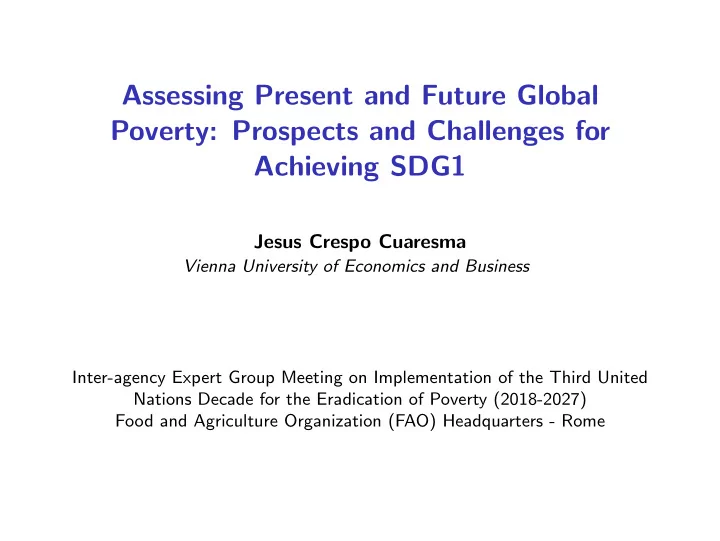

Assessing Present and Future Global Poverty: Prospects and Challenges for Achieving SDG1 Jesus Crespo Cuaresma Vienna University of Economics and Business Inter-agency Expert Group Meeting on Implementation of the Third United Nations Decade for the Eradication of Poverty (2018-2027) Food and Agriculture Organization (FAO) Headquarters - Rome
Roadmap ◮ Modelling and projecting poverty rates worldwide ◮ The future of poverty: Will SDG1 be fulfilled? ◮ Thinking ahead: New methods to assess poverty ◮ Development policy and the future of poverty 2 / 19
The dynamics of extreme poverty ◮ Need for monitoring poverty dynamics worldwide to assess the fulfilment of SDG1 and anticipate challenges to poverty reduction ◮ Modelling income per capita and its distribution 3 / 19
Human Capital and Income Projections ◮ Assume an aggregate projection function where total income growth depends on the accumulation of physical and human capital (differentiated by age and educational attainment) ◮ In addition, assume that total factor productivity depends on the stock of human capital, the distance to the technology frontier and its interaction ◮ We estimate the parameters of the model using a global panel dataset which spans information for 120 countries for the period 1970-2010 at 5 year intervals ◮ Combine short and medium-term IMF forecasts with long-term forecasts computed for the IPCC’s Shared Socioeconomic Pathways 4 / 19
Shared Socioeconomic Pathways ◮ Thinking about the future of climate change using projections (Kriegler et al., 2012; O’Neill et al., 2014) 5 / 19
Population Projections in the SSPs Figure: Kenya in 2000 : Population by Age, Sex and Educational Attainment 6 / 19
Population Projections in the SSPs Figure: Kenya in 1990 : Population by Age, Sex and Education 7 / 19
Population Projections in the SSPs Figure: Kenya in 1980 : Population by Age, Sex and Education 8 / 19
Population Projections in the SSPs Figure: Kenya in 1970 : Population by Age, Sex and Education 9 / 19
Population Projections in the SSPs (2020) (2030) (2040) (2050) 10 / 19
Shared Socioeconomic Pathways PPP Adj djusted Dollars Per Capita 100000 120000 20000 40000 60000 80000 0 1980 1985 Figure: Projections of GDP per capita, world SSP5-World SSP4-World SSP3-World SSP2-World SSP1-World 1990 1995 2000 2005 2010 2015 2020 2025 2030 2035 2040 2045 2050 2055 2060 2065 2070 2075 2080 2085 2090 2095 2100 11 / 19
Average incomes and the poor ◮ Reducing poverty: ◮ increasing mean income for a given level of inequality ◮ reducing inequality for a given level of income ◮ Economic growth (of mean incomes) is good for the poor: 12 / 19
The future(s) of extreme poverty ◮ Shift distribution of income per capita for all countries of the world making use of GDP per capita projections to obtain poverty nowcasts and projections (Crespo Cuaresma, 2017; Crespo Cuaresma et al., 2018), documented at the World Poverty Clock 13 / 19
The future(s) of extreme poverty ◮ SDG1 fulfilment prospects: 2020-230 ◮ The world in 2020: 14 / 19
The future(s) of extreme poverty ◮ SDG1 fulfilment prospects: 2020-230 ◮ Going subnational, Kenya: 15 / 19
When data are not available ◮ Night light emissions as proxy for income (Henderson et al., 2012) 16 / 19
Designing development policy ◮ Natural link to the evaluation of education and health policy ◮ The demographic dividend as an education dividend (Lutz et al., 2019): the example of Nigeria 17 / 19
Literature ◮ On night lights and income: ◮ Henderson, J. V., Storeygard, A., and Weil, D. N. (2012). Measuring economic growth from outer space. American Economic Review , 102(2), 994-1028. ◮ On income and poverty projections: ◮ Crespo Cuaresma, J. (2017). Income projections for climate change research: A framework based on human capital dynamics. Global Environmental Change , 42, 226-236. ◮ Crespo Cuaresma, J., Fengler, W., Kharas, H., Bekhtiar, K., Brottrager, M., and Hofer, M. (2018). Will the Sustainable Development Goals be fulfilled? Assessing present and future global poverty. Palgrave Communications , 4(1), 29. ◮ Lutz, W., Crespo Cuaresma, J., Kebede, E., Prskawetz, A., Sanderson, W. C., Striessnig, E. (2019). Education rather than age structure brings demographic dividend. Proceedings of the National Academy of Sciences, 116(26), 12798-12803. 18 / 19
Literature ◮ On poverty and economic growth: ◮ Dollar, D., and Kraay, A. (2002). Growth is Good for the Poor. Journal of Economic Growth , 7(3), 195-225. ◮ Dollar, D., Kleinberger, T. and Kraay, A. (2016). Growth Still Is Good for the Poor. European Economic Review , 81, 68-85. 19 / 19
Recommend
More recommend